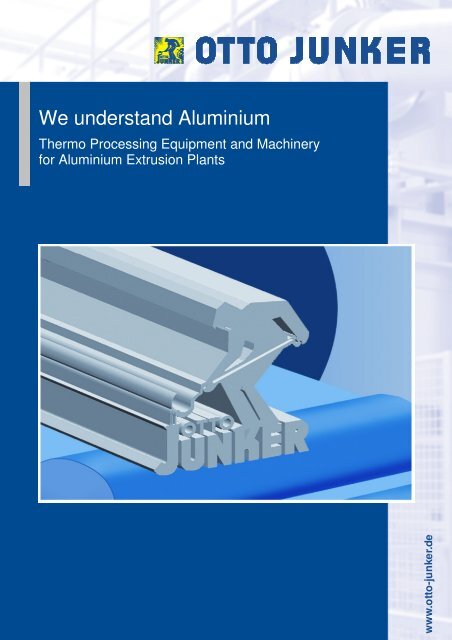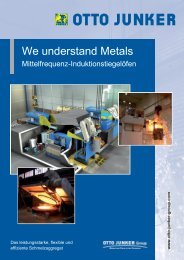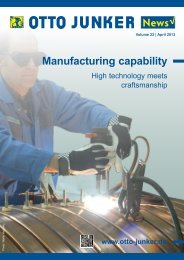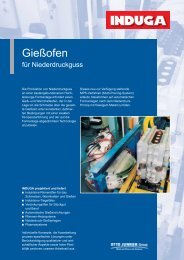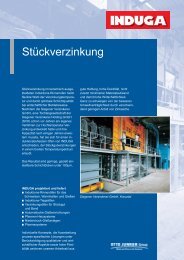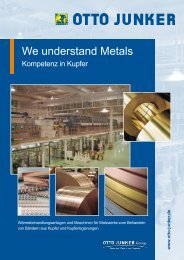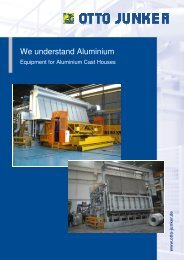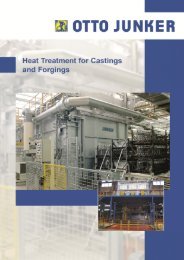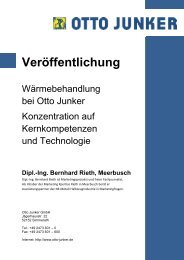Aluminium Extrusion Plants - Otto Junker GmbH
Aluminium Extrusion Plants - Otto Junker GmbH
Aluminium Extrusion Plants - Otto Junker GmbH
Create successful ePaper yourself
Turn your PDF publications into a flip-book with our unique Google optimized e-Paper software.
1 / 8<br />
We understand <strong>Aluminium</strong><br />
Thermo Processing Equipment and Machinery<br />
for <strong>Aluminium</strong> <strong>Extrusion</strong> <strong>Plants</strong><br />
www.otto-junker.de
Equipment for <strong>Aluminium</strong> <strong>Extrusion</strong> <strong>Plants</strong><br />
The high innovation potential of aluminium in modern<br />
process and application engineering keeps presenting<br />
equipment makers with new challenges. Specifically<br />
the increasing use of high quality aluminium extrusions<br />
calls for narrower quality tolerances and improved levels<br />
of process reliability and repeatability. Perpetual<br />
cost reductions and the simultaneous expansion of automation<br />
and process control capabilities have evolved<br />
into essential tasks in innovative plant development<br />
OTTO JUNKER provides advanced solutions for important<br />
extrusion plant processes, making your investments<br />
economically successful and environmentally<br />
compatible.<br />
Each single link of the complete process chain is<br />
important for product quality and operating cost.<br />
Your expert contact:<br />
Mr. Jürgen Stengel<br />
Phone: + 49 2473 601 310<br />
Fax: + 49 2473 601 620<br />
E-Mail: stj@otto-junker.de<br />
2 / 8
Billet Preparation<br />
Log magazines<br />
The gravity magazine table is the most straightforward<br />
log storage system. A chain-type magazine reduces the<br />
noise emitted during transfer to the feeding conveyor.<br />
These magazines are loaded by a forklift truck.<br />
The combination of the one-layer table with a vertical<br />
magazine offers high storage capacity and makes it<br />
possible to store logs sorted by production order or alloy.<br />
Loading and unloading is performed by a manipulator<br />
travelling across the magazine wells.<br />
A space-saving alternative to a feed-in table and vertical<br />
storage combination is the multi-layer stacking magazine.<br />
Logs are removed from each layer by a hydraulic lift<br />
which places them on the feeding roller conveyor to the<br />
heater. The magazine is loaded by forklift truck on the<br />
side opposite the lift.<br />
Your benefits<br />
All kinds of magazines available<br />
High automation capability<br />
High flexibility in your production<br />
Logs returning from the heater can be stored again both<br />
in the vertical magazine and in the multi-layer stacking<br />
magazine.<br />
Hot and cold log saws<br />
This revolutionary design relies on two saw blades for<br />
cutting the logs into billets. The use of two blades allows<br />
each blade to be made thinner, which reduces the kerf<br />
width and thus the amount of swarf produced.<br />
The saw may operate as a cold saw upstream of an induction-type<br />
billet heater, or as a hot saw downstream of<br />
a gas-fired log heater. In either case, a swarf extraction<br />
system is supplied with the saw.<br />
Your benefits<br />
Small kerf width<br />
Less swarf<br />
3 / 8
Log welders<br />
A log welder operating on the friction stir welding principle<br />
provides the ability to join short log or billet ends<br />
to the next log so that a virtually endless log is obtained.<br />
This technology maximizes production yield<br />
while reducing scrap, assuming that two-part billets<br />
are supported by the application. Friction stir welding<br />
uses only the parent metal with no filler alloy required,<br />
so that the amount of scrap from each extrusion is minimized.<br />
The log welder may operate in conjunction with a cold<br />
saw at an induction-type billet heater or with a hot saw<br />
at a gas-fired log heater. In the latter case, the oddend<br />
management system is not required.<br />
Your benefits<br />
Reduced log scrap<br />
Fewer disruptions<br />
Log and billet brushing systems<br />
A brush system may be installed to clean the log or<br />
billet surface upstream of the heater. This system is<br />
available for dry brushing of logs with dust extraction<br />
in continuous mode or for wet brushing of billets in<br />
step continuous mode.<br />
.<br />
Your benefits<br />
<br />
Clean log or billet surface<br />
4 / 8
Gas-fired log heaters<br />
The most common log heating system in aluminium extrusion<br />
plants today is the gas-fired rapid heater which<br />
may be combined with a hot billet shear or hot saw.<br />
The use of driven conveyor rollers supported in bearing<br />
assemblies external to the heater helps greatly to reduce<br />
roller wear. Moreover, the heater can be emptied without<br />
problems and an optimum flow of combustion gases<br />
around the log is ensured. Options available include the<br />
proven chain drive system, a walking beam system or the<br />
widely employed solution based on idling rollers.<br />
Your benefits<br />
All conveying systems available<br />
(driven or idling rollers, chains or walking<br />
beam)<br />
Low emissions across all load ranges<br />
Low energy consumption of preheat chamber<br />
and heating zone<br />
Good efficiency, even in part-load operation,<br />
reduces energy consumption<br />
In the heating zone, an advanced gas/air control system<br />
(optionally with lambda control) is combined with<br />
high-efficiency long-life burner nozzles. Short control<br />
zones near the exit end of the heater facilitate the application<br />
of a temperature gradient.<br />
Temperature measurements for each zone are taken by<br />
means of four measuring tips (for control and monitoring).<br />
The complete heater system includes an exhaust-gas<br />
fan, a heater pressure control system and highconvection<br />
(or counter-current) preheat chamber for<br />
optimum heat recovery from the exhaust-gases.<br />
Hot log shears<br />
The use of a hot shear or hot saw in conjunction with a<br />
gas-fired log heater minimizes scrap. At the same time,<br />
the costly and time-consuming process of storing presawn<br />
billets is eliminated.<br />
Your benefits<br />
Split shearing and clamping bushes<br />
Rugged and reliable hydraulic system<br />
Low maintenance requirements<br />
Scrap is further reduced through the use of a scrapless<br />
odd-end control system. This system determines and<br />
prevents formation of critically short remaining log ends<br />
with the aid of a dedicated computing programme. A<br />
so-called compensation cut is performed to ensure that<br />
only lengths will be obtained that can be safely handled<br />
and conveyed. First, the residual log is cut in the<br />
middle. Its front half remains on the billet trough of the<br />
hot shear, while the rear half is moved into a parking<br />
position. The front half will thus become part of a twopart<br />
billet, entering the extrusion press together with the<br />
first section of the following log. The parked second half<br />
(“compensation piece”) is transferred back into the heater,<br />
e.g., to heat its head. For the extrusion of safety<br />
parts and similar applications, the software provides<br />
further options such as “single-part billets only” or<br />
“sawn billet surfaces only”.<br />
5 / 8
Induction billet heaters<br />
For heating or final heating of aluminium extrusion billets<br />
and for taper heating to apply a temperature gradient over<br />
the billet length, the single-billet induction heater is the<br />
ideal solution.<br />
Adapted to the maximum billet length, this induction heater<br />
is equipped with three to six separately controlled<br />
zones over the coil length.<br />
Billet loading and unloading from the induction heater can<br />
be performed without friction between billet and handling<br />
system.<br />
The induction log heater with attached hot shears or hot<br />
saw is an interesting, flexible alternative to the singlebillet<br />
induction heater.<br />
Ever since 2000, the high-power systems of our singlebillet<br />
heaters will normally incorporate OTTO JUNKER‘s<br />
proprietary IGBT technology. These transistorized frequency<br />
converter systems offer numerous technical advantages.<br />
Your benefits<br />
High and reproducible temperature accuracy<br />
Stepless power control for each coil section<br />
Power input adjustable to billet length<br />
Low maintenance needs thanks to digital control and reliable magnetic field extender<br />
Uniform mains load<br />
High power factor<br />
No surface marking by billet handling operations<br />
High efficiency, low power consumption<br />
Heaters available for billets or logs<br />
6 / 8
Profile cooling<br />
Cooling systems are arranged in the press axis, starting<br />
immediately downstream of the platen. The parameter<br />
settings for all cooling devices of an extrusion line can<br />
be saved under a given die number and will thus be fully<br />
reproducible.<br />
When extrusion has started, the cooling hoods move into<br />
their cooling position automatically, depending on the<br />
puller position. Separate air, water spray and water<br />
wave cooling units or combined interchangeable cooling<br />
units can be arranged in the press run-out section.<br />
The bottom air and water nozzles are integral parts of<br />
the lead out table connecting to the press run-out. The<br />
cooling hoods carry nozzles at the sides and at the top<br />
The air and water flow from all sides can be separately<br />
controlled. Cooling air is supplied by radial fans through<br />
air ducts.<br />
The available design solutions allow the integration<br />
into existing puller and hot saw systems.<br />
Your benefits<br />
Adjustable cooling intensity<br />
High air cooling performance<br />
All cooling systems available<br />
Interchangeable cooling equipment<br />
7 / 8
OTTO JUNKER offers an extensive range of equipment for the manufacture<br />
of semi-finished aluminium products. Our product range also includes the<br />
following<br />
Fuel-fired<br />
melting and pouring plants<br />
Induction melting and pouring<br />
plants<br />
Homogenizing plants<br />
Process competence:<br />
Technological competence:<br />
OTTO JUNKER has the capability to supply sophisticated<br />
process equipment for melting, casting, preheating<br />
and heat treatment from a single source.<br />
Our equipment is supplied to the aluminium extrusion<br />
industry all over the world.<br />
The OTTO JUNKER has many decades of expeand<br />
remains committed to ongoing product<br />
development and improvement. As a result, our<br />
equipment will embody the most up-to-date technology<br />
at all times. Apart from proprietary development,<br />
OTTO JUNKER cooperates closely with the<br />
Technical University of Aachen<br />
rience (RWTH).<br />
OTTO JUNKER <strong>GmbH</strong><br />
Postfach 11 80 • D-52147 Simmerath<br />
Tel.: +49 2473 601-0 • Fax: +49 2473 601-600<br />
E-Mail: info@otto-junker.de<br />
www.otto-junker.de<br />
8 / 8


